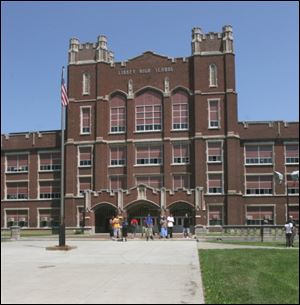
State panel endorses idea of Libbey High on national register
7/15/2011
Libbey High School.
EDITOR'S NOTE: This version corrects the name of Toledo board member Brenda Hill and updates the date of the auction to August 10, originally listed as August 8.
COLUMBUS — A state panel Friday gave its unanimous blessing to efforts to place the closed Libbey High School on the National Register of Historic Places as those trying to save the building race against the wrecking ball.
Several members of the governor-appointed Ohio Historic Site Preservation Advisory Board shook their heads when Toledo Public Schools board member Brenda Hill used the word "demolition” when she advised the panel of last-ditch efforts to sell the building at auction on Aug. 10.
Mary Olding, a historian member of the advisory board, characterized Libbey as "stunning architecture” and praised "the obvious use of quality material in a city that was experiencing enough growth due to industries that both the Libbey and Owens families represented."
The panel has recommended that the Ohio Historical Society formally nominate Libbey for inclusion on the national register, a decision that will ultimately be made by the National Parks Service. Supporters of the building, including former alumni, hope such a designation may buy the school time and attention and that a buyer will step forward to put the building to constructive use.
Otherwise, Ms. Hill said the school district will have little choice but to move forward with its plans by the end of the year to demolish the massive structure in order to take advantage of greater state financial aid. The school board took no position Friday on the inclusion of the building on the National Register, but that process would not preclude the district from moving ahead with its own plans.
"It is a grand building…, but our school system just can’t afford it," Ms. Hill told the board.
The district has placed a minimum bid of $395,000 on the building at next month’s auction, a high price that Ms. Hill said is designed to ensure that whoever bids on it has the financial wherewithal to follow through with its development plans so that the structure doesn’t become a public nuisance.
The original Collegiate Gothic portion of the building named for Libbey Glass founder and philanthropist Edward Drummond Libbey dates to 1923 and was designed by Edwin M. Gee, the supervising architect for city schools at the time. It was expanded in the 1950s with an athletic field house and in the 1970s with a career center.
The panel agreed to recommend the nomination of the building, not only because of its significant architecture, but also as an historic example of how public education evolved in a city like Toledo that experienced significant industrial and population growth last century.
Albert Blackwood, of Perrysburg, a board member representing the general public, made the motion to give Libbey the board’s blessing. His son taught there for two years.
"I’ve walked the halls of Libbey a number of times and also the sports complex," he said. "It’s very well maintained and very well intact the way it was built."
Nine people attended Friday’s meeting to promote the building for the registry. They hope that the designation could add to the value of the building, encouraging someone to take advantage of potential federal and state historic preservation tax credits to put the building back to use and potentially create jobs.
"We can make a strong case for any revitalization efforts, which seem to be the norm and trend across the country," said Larrie Baccus, president of Libbey Alumni, Inc. "We have an opportunity in Toledo to use this as a means to revitalize an entire community, the South End, by preserving a masterpiece."